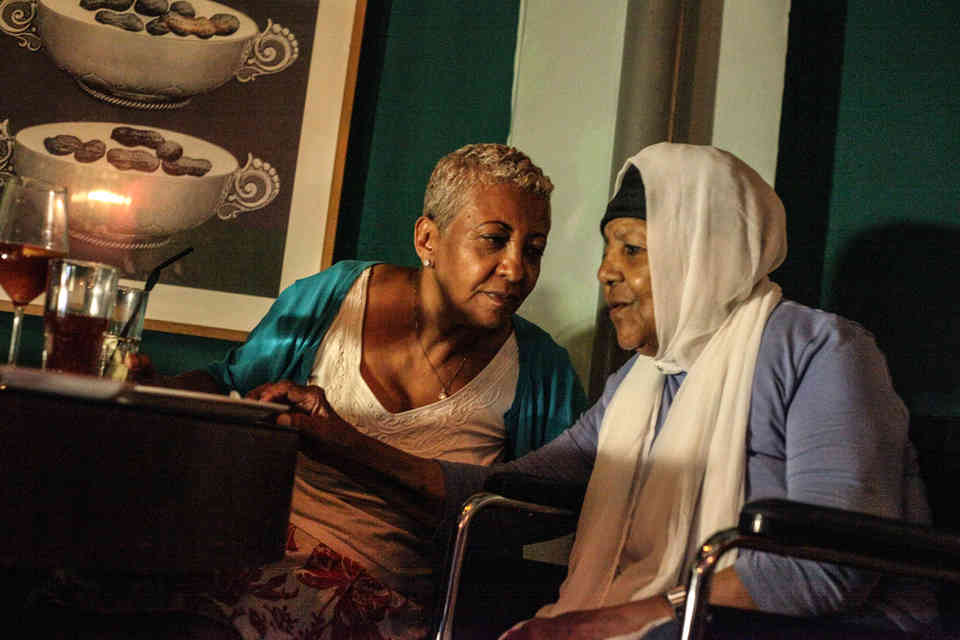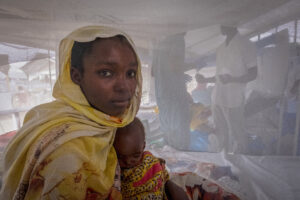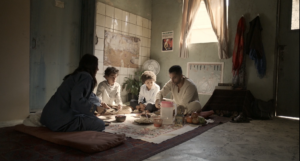The Transcendental Emahoy Tsegué-Maryam Guèbrou
The Ethiopian pianist blended the sacred and secular, European and African. The pianist and a friend via via Emahoy Music Publisher / CC BY-SA 3.0
The pianist and a friend via via Emahoy Music Publisher / CC BY-SA 3.0
In the 1960s, Emahoy Tsegué-Maryam Guèbrou, the Ethiopian composer and pianist who died last month at the age of 99, undertook a study of the sacred music of the sixth-century composer Saint Yared. Yared is credited with the creation of the liturgical chants of the Ethiopian Orthodox Tewahedo Church in which Emahoy was a nun. One of the oldest Christian churches of sub-Saharan Africa, its chants, called zema, are divided into three styles: ge’ez, araray, and ezel. Though frequently called modes, these styles of chant are different from Western church modes, which are just scales. Zema modes instead dictate qualities like octave range, performance style, and mood, but not necessarily pitch. These modes are, according to the church, divine in nature.
This tradition of sacred music developed in contrast to Ethiopian secular music, or zefen. In Ethiopia, the distinction between secular and sacred music is significant. Among some Ethiopian Christians, especially Protestants, zefen is considered morally dubious; among others, it is a significant cultural inheritance. Early practitioners of secular music, called azmari, were steeped in sacred music, and though unable to perform zema, they nevertheless borrowed from it certain characteristics, such as its melismatic runs and free rhythms. Having been primarily passed down orally, Ethiopian secular music has concretized into easily learned scales called qeñet. They are: bati, ambassel, anchihoye, and tizita, all of which correspond as well to specific styles of song. Tizita, for example, is a kind of mournful ballad, and its major scale is the major pentatonic scale of Western tonality, which can be played by hitting just the black keys on the keyboard.
Though the qeñet are essential to Ethiopian folk forms, they happen to correspond to scales that are shared by musical traditions from all over the world. In China, the major pentatonic scale is called gong; in North India, bhoopali; and so forth. It’s also featured in many American spirituals and folk songs, like “Amazing Grace” and “Oh! Susanna,” and it is deployed across the Western classical repertoire, most famously in works like Dvořák’s “New World” symphony and “American” quartet, where it’s used to channel a distinct kind of American folksiness.
It’s no coincidence that Southern American bluesmen and sub-Saharan itinerants have similar scales, given the diasporic spread of African folk forms across continents. It may well be that the accidental “American-ness” of the tizita has something to do with the crossover popularity of Ethiopian music in the past several decades, as well the occasional neocolonialist condescension (in the form of endless reductions to “bluesiness”) with which some practitioners, like Emahoy, have been met.
But Emahoy’s compositions, which combine the annular beauty of Ethiopian zefen, the sacred intensity of zema, and the structural harmony of Western classical music, have a unique provenance that isn’t reducible to conventional wisdom surrounding either Ethiopian traditional music or the migration of African musical forms. They must be taken on their own terms and understood in the context of Emahoy’s remarkable life.
Though zema is an important aspect of Orthodox culture, the debtaras who perform it are all men, and so Emahoy had to abandon her musical practice during her ten years at the monastery.
Emahoy, born Yewubdar Guébrou first learned the Western classical music canon at boarding school in Switzerland, where she was among the first Ethiopian girls to study abroad. Her education would be disrupted by Mussolini’s barbarous invasion of Ethiopia in 1936. Thirteen-year-old Yewubdar was imprisoned along with her family and exiled to the island of Asinara. Three of her brothers were executed. Afterward, she went to Cairo to continue her musical studies with the Polish violinist Alexander Kontorowicz. Eventually she was offered a place at the Royal Academy of Music in London, but was denied travel by Ethiopian authorities. Disconsolate, it is said that she ceased eating for twelve days and nearly died. This experience resulted in a spiritual epiphany that caused her to retreat to the Gishen Maryam Ethiopian Orthodox monastery, 300 miles north of Addis Ababa, in the mid-1940s.
Though zema is an important aspect of Orthodox culture, the debtaras who perform it are all men, and so Emahoy had to abandon her musical practice during her ten years at the monastery. She lived there as an ascetic, focusing almost exclusively on prayer. Eventually, the leader of Gishen Maryam died and she returned to Addis, where she began to compose again, delving into Ethiopian sacred music and taking inspiration from the Western classical masters she studied in her youth.
It wasn’t until 1967 that she put anything to tape. The eventual recordings for solo piano, performed by Emahoy herself, suggest the stylistic influence of European composers for solo piano, like Chopin and Schumann, but shirk easy categorization. Though the voicings and textures are akin to the 19th-century Romantics, the harmonic development of Romanticism is pared away. The influence of Yared is evident in the tumbling melodies that subtly change shape, yet much of the music is built from the qeñets of Ethiopian secular music.
For example, “Homesickness,” one of her most popular works, is a tizita. Emahoy’s left hand lingers on two chords, tonic and dominant, while her right hand traces the dappled pentatonic melodies. As the short piece progresses, the tizita melody seems to elongate, situating itself in multiple registers, suggesting the obsessiveness of melancholy and the way nostalgia turns our best-loved memories to heartbreak. It has a spiritual feeling, though its concerns are plainly earthbound. “Golgotha,” denser and more dissonant, features a sophisticated modal mixture. The piece finds a gorgeously understated climax in the turn from the F-minor major 7 chord to the C-major chord—as distinctly Romantic a change as one can write—before modulating back to the minor qeñet with which it opens. The shifting harmonies and scampering melodies marry Western classical and traditional Ethiopian styles in a syncretism as visionary as Bartók’s. But where Bartók pilfered from the colonial metropole, Emahoy, herself a subject of Western imperialist violence, synthesized from the periphery.
It may be that Emahoy desired to be taken seriously by those who would otherwise pigeonhole her work.
It is tempting to interpret Emahoy’s work in a postcolonial framework. Western classical music has been staggeringly exclusive of women of color, and in particular of non-European or American women. Where some progress has been made in terms of representation of women and non-Western composers by orchestras in the past five years, increases from zero can serve as embarrassing consolations. Moreover, the unbalanced exchange between African, Middle Eastern, and African-American and Western classical and folk music has foregrounded the material inequities upon which the past century of canon construction has relied.
But Emahoy’s case is complex. She was born into an upper-class family—her father was a diplomat—that could afford Swiss boarding school and Egyptian sojourns. Her music was essentially unknown in the West before the French musicologist Francis Falceto released her recordings as Ethiopiques, Vol. 21 in 2005. The subsequent breathless appraisals did not lack condescension. The BBC called her “the Honky Tonk Nun.” An article in the Guardian described her music as “bluesy” and “freewheeling.” Such descriptions are odd given that, according to Israeli composer Maya Dunietz, who organized a tribute concert to Emahoy in her adopted home of Jerusalem, “in her own eyes, [Emahoy] sees herself as continuing the legacy of Beethoven and Schumann and Chopin and Brahms.”
Emahoy remarked that she could not identify the influence of Ethiopian music in her compositions, let alone the jazz and blues stuff that her appreciators have earmarked, and which she claimed not to have ever heard. While it’s likely true that she listened to little blues or jazz, it seems inarguable, listening to recordings of Asnaqètch Wèrqu’s krar music and Alèmu Aga’s begena, that the traditional music of Ethiopia determined at least some of Emahoy’s melodic, harmonic, and rhythmic sensibilities. What is particularly Ethiopian in Emahoy’s music greatly enriches, and troubles, her classicism. For example, her scores apparently feature no meter, and it is evident from her recordings that such considerations as bar-length and tempo were determined instinctively. “It depends on the day,” she said about how she counted her compositions, “on the mood, on the weather, on your feeling at that moment.”
These inheritances were for Emahoy so intuitive as to be unremarkable. It makes sense, then, that she would instead emphasize the role that Western classical composers played in her musical development. It may be that Emahoy desired to be taken seriously by those who would otherwise pigeonhole her work. After all, if Dvořák or Bartók could borrow folk scales for their compositions and not be reduced to regional curios, surely Emahoy could, too. If it was her wish to be considered alongside the European masters, it should certainly be allowed, and having been allowed, it should be asked whether Chopin has ever been described as “honky tonk.”
Within this melange, what is particular to Emahoy surfaces and then dissolves away into beatitude
In lieu of relying on offhand comparisons to American folk forms, it’s worth considering Emahoy’s work in the broader context of 20th-century composition. Some European composers of sacred music, like Arvo Pärt and Henryk Gorecki, come to mind as kindred spirits. These Eastern European minimalists found inspiration in the belief that, to use Pärt’s words, “instant and eternity are struggling within us.” This duality gets us close to the core of Emahoy’s project. Like Pärt, Emahoy was concerned with expressing aspects both divine and human in her work. But Emahoy lingers in little moments more than the sacred minimalists. Her compositions are often named after small but profound things: “Mother’s Love,” “A Young Girl’s Complaint,” “Evening Breeze.” Where she took on biblical topics, she tended to represent scenes in scripture, rather than grand religious concepts. “Garden of Gethesemanie,” one of her most classical-sounding pieces, cycles between minor and diminished chords rendered horizontally before landing on the major triad, channeling Christ’s moment in the eponymous garden, where he experienced profound pain over and subsequently accepted his coming betrayal and crucifixion. “Golgotha,” another name for Calvary, the site of Christ’s crucifixion, has a similar narrative rendering.
Emahoy seemed to raise the emotional worlds of her subjects, the contradictions, the banality, the cycles of despair, resignation, and acceptance, above other considerations. In this sense, her music is almost programmatic. By taking these instants and rendering them in terms of the eternal—in terms of the looping, anfractuous melodies of sacred music—Emahoy aimed for reconciliation between the two. It may be that the inviting character of her work, despite its preoccupation with suffering, stems from this conciliatory outlook. “Loneliness grew up with me like a childhood friend,” Emahoy once wrote. Where Pärt found struggle, Emahoy found affinity. Where others told, Emahoy showed.
In expressing the beauty and simplicity of everyday feeling in the context of religious music, Emahoy suffused the quotidian with sacred significance. On the one hand, her connection here with Saint Yared and Tewahedo music is vital: the insistent, roundabout lines, the sublime, religious intensity. Her melodies seem to be dictated by a logic similar to Ethiopian church modes: rather than being carved into stone, Emahoy’s melodies expand and contract according to mood, and the effect is entrancing in a manner akin to church music, which attempts to instill in the listener a sense of deific grandeur.
But her concerns are more frequently those of the azmari: the day-to-day heartbreak (“Tenkou! Why Feel Sorry?”), the beauty of nature (“Song of the Sea”), the specific places she has visited (“The Home of Beethoven”), even current events (“Famine Disaster 1974”). Recall that the blending of sacred and secular forms in Ethiopia is still a matter of some contention. I do not know whether courting controversy was something with which Emahoy was concerned; but such a synthesis, and coming from an Orthodox nun, is radical. In giving these topics the holiest of presentations, Emahoy channels a—dare I say it?—humanist universality that I’d consider one of the dual aspects of Christian art, the other being transcendence. Emahoy’s music seems to assert the unity of miaphysitism, one of the doctrines of the Ethiopian Orthodox Church that the Western churches dispute, which holds that the human and the divine in Christ are married in one nature. God-given, her music shoots straight to the heart of human feeling.
Emahoy was an Ethiopian composer. But her life and work resist glib interpretations that might wholly reduce her to geographic or cultural specificities. It is, of course, important that an African woman composer be considered worthy of canonization—bracketing whether canon construction is useful or interesting at all—and her synthesis undiminished by a rigid, patronizing Western critical and commercial apparatus. But her disavowals are also, maybe, an exhortation to transcendence, and they make a case for an eclecticism that blends sacred and secular, European and African. Within this melange, what is particular to Emahoy surfaces and then dissolves away into beatitude. Perhaps her work, like the chants of Saint Yared, is also of a divine nature. “My music is a gift from God,” she once said. “I had nothing to do with it.”
Your support matters…Independent journalism is under threat and overshadowed by heavily funded mainstream media.
You can help level the playing field. Become a member.
Your tax-deductible contribution keeps us digging beneath the headlines to give you thought-provoking, investigative reporting and analysis that unearths what's really happening- without compromise.
Give today to support our courageous, independent journalists.






You need to be a supporter to comment.
There are currently no responses to this article.
Be the first to respond.